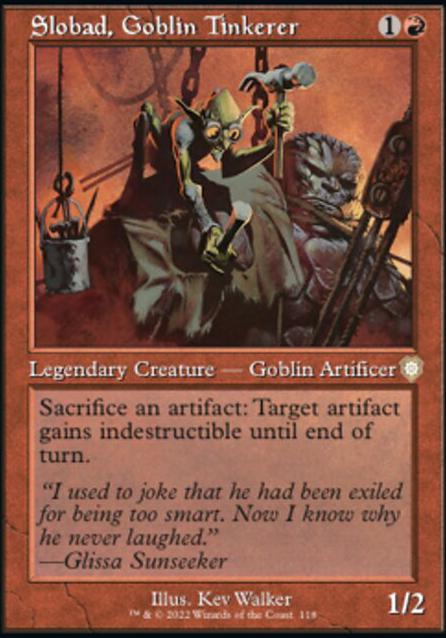
Slobad - Self-Mill/Eggs (Competitive)
Commander / EDH Artifact Combo Competitive Infinite Combo Mono-Red Multiplayer
Combo (7)
- 1x Basalt Monolith
- 1x Goblin Cannon
- 1x Krark-Clan Ironworks
- 1x Mesmeric Orb
- 1x Metalworker
- 1x Rings of Brighthearth
- 1x Staff of Domination
Discount (3)
Draw (10)
- 1x Faithless Looting
- 1x Magmatic Insight
- 1x Magus of the Wheel
- 1x Memory Jar
- 1x Reforge the Soul
- 1x Sandstone Oracle
- 1x Skullclamp
- 1x Tormenting Voice
- 1x Wheel of Fortune
- 1x Wild Guess
Egg (6)
Hate (3)
Interaction (8)
- 1x Chaos Warp
- 1x Galvanic Blast
- 1x Lightning Bolt
- 1x Pyroblast
- 1x Pyroclasm
- 1x Red Elemental Blast
- 1x Tormod's Crypt
- 1x Vandalblast
Land (28)
- 1x Ancient Tomb
- 1x Arid Mesa
- 1x Bazaar of Baghdad
- 1x Blinkmoth Nexus
- 1x Bloodstained Mire
- 1x Boseiju, Who Shelters All
- 1x Buried Ruin
- 1x City of Traitors
- 1x Crystal Vein
- 1x Darksteel Citadel
- 1x Great Furnace
- 1x Inkmoth Nexus
- 1x Mishra's Factory
- 1x Mishra's Workshop
- 10x Mountain
- 1x Scalding Tarn
- 1x Strip Mine
- 1x Wasteland
- 1x Wooded Foothills
Ramp (11)
Recursion (9)
- 1x Daretti, Scrap Savant
-
1x
Goblin Welder

- 1x Junk Diver
- 1x Myr Retriever
-
1x
Past in Flames

- 1x Recoup
- 1x Salvaging Station
- 1x Scrap Mastery
- 1x Trash for Treasure
Ritual (4)
Tutor (3)
Utility (7)
- 1x Clock of Omens
- 1x Codex Shredder
- 1x Lightning Greaves
- 1x Scroll Rack
- 1x Sensei's Divining Top
- 1x Swiftfoot Boots
- 1x Voltaic Key
Commander (1)
Suggestions
Updates Add
Comments View Archive
Attention! Complete Comment Tutorial! This annoying message will go away once you do!
Important! Formatting tips — Comment Tutorial — markdown syntax
Please login to comment
| Top Ranked |
|
| Date added | 10 years |
| Last updated | 7 years |
| Exclude colors | WUBG |
| Legality | This deck is not Commander / EDH legal. |
| Rarity (main - side) | 7 - 0 Mythic Rares 36 - 0 Rares 33 - 0 Uncommons 14 - 0 Commons |
| Cards | 100 |
| Avg. CMC | 2.22 |
| Tokens | Emblem Daretti, Scrap Savant |
| Folders | interesting decks, EDH, Reference Decks, Decks I Like, dank decks, Decks, EDH, EDH decks, Decks that I like and I want to look at again sometime, stuff i might build |
| Votes | |
| Ignored suggestions | |
| Shared with | |
| Views |

